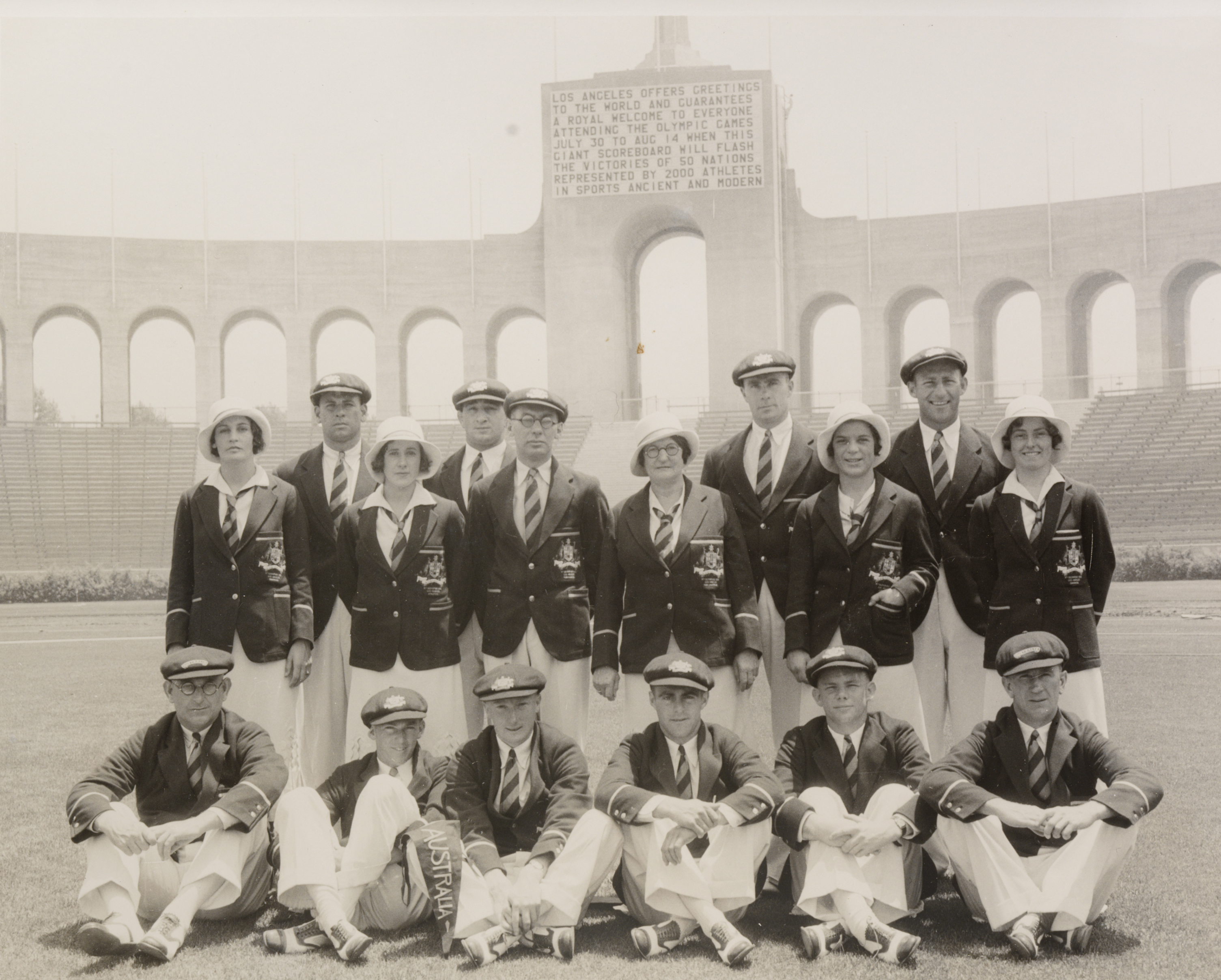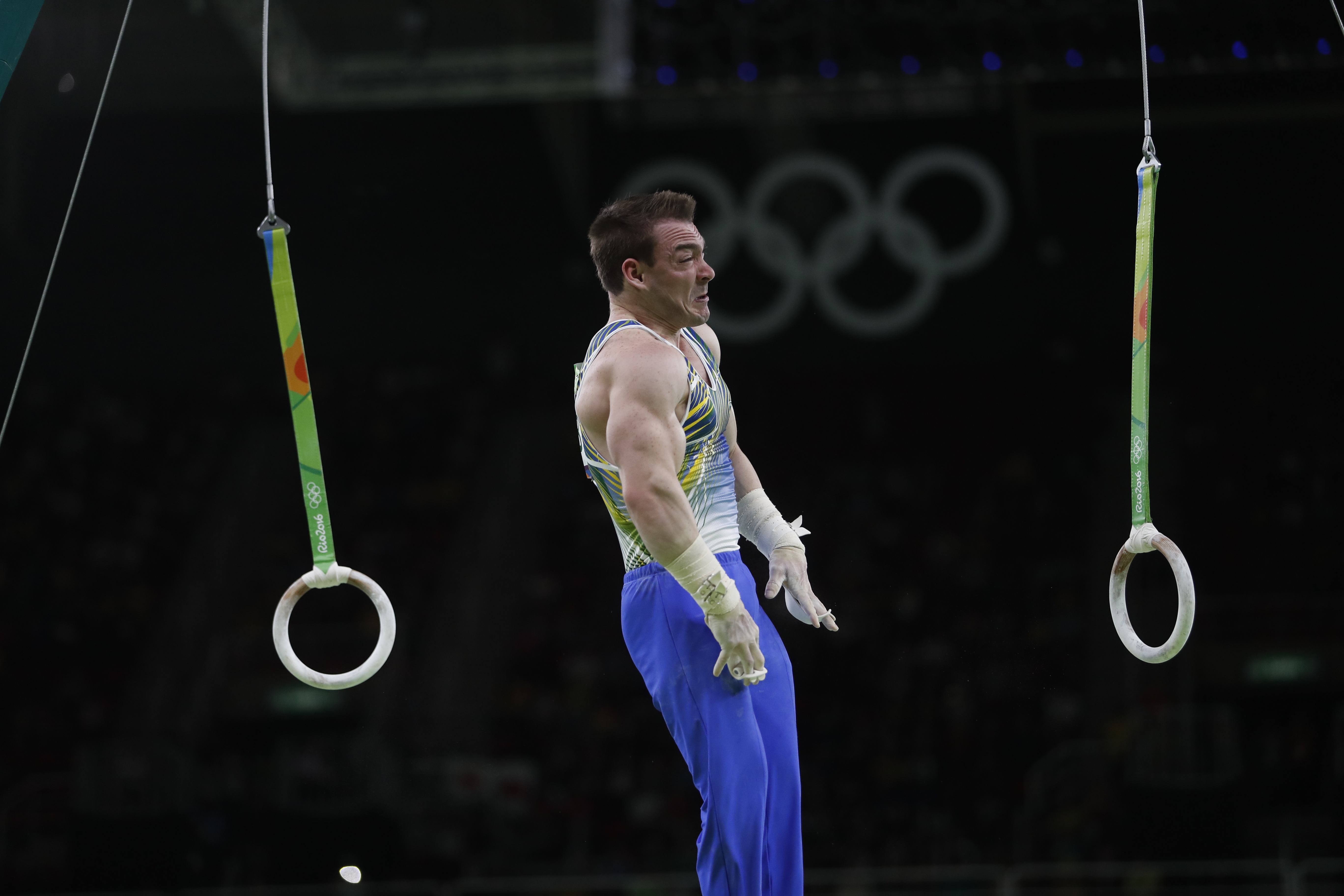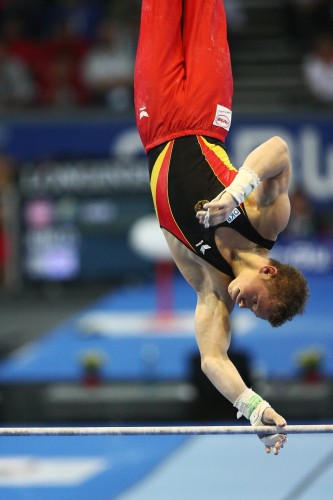|
Boris Gregorka
Boris Gregorka (2 August 1906 – 19 March 2001) was a Slovenian gymnast, competing for Yugoslavia. He won a bronze medal at the 1928 Summer Olympics. After retiring from competitive career, he was the coach of a double Olympic gold medallist Miroslav Cerar. Biography Gregorka was born in Brežice. At the age of seven, his parents introduced him to the Sokol athletics movement in Ljubljana, where he later achieved several successes. Gregorka was rather tall for a gymnast, 181 cm. This made him best-suited for pommel horse, which was also his best discipline. With his Sokol team, Gregorka was the team winner in all five national competitions for "The Sword of King Alexander" award. Gregorka competed at two Olympics. He was a member of the Yugoslavian delegation at the 1928 Summer Olympics in Amsterdam; he won a bronze medal with the men's all-around team, together with Edvard Antosiewicz, Dragutin Ciotti, Stane Derganc, Anton Malej, Janez Porenta, Jože Primožič, and Le ... [...More Info...] [...Related Items...] OR: [Wikipedia] [Google] [Baidu] |
Gymnastics At The Summer Olympics
Gymnastics events have been contested at every Summer Olympic Games since the birth of the modern Olympic movement at the 1896 Summer Olympics in Athens. For 32 years, only men were allowed to compete. Beginning at the 1928 Summer Olympics in Amsterdam, women were allowed to compete in artistic gymnastics events as well. Rhythmic gymnastics events were introduced at the 1984 Summer Olympics in Los Angeles, and trampoline events were added at the 2000 Summer Olympics in Sydney. Summary Artistic gymnastics Men's events Women's events Medal table ''(1896–2020)'' Nations Nations competing in artistic gymnastics, and the number of gymnasts (male and female) each nation brought to each Olympics, are shown below. Rhythmic gymnastics Events Medal table ''(1984–2020)'' Nations Nations competing in rhythmic gymnastics and the number of gymnasts each nation brought to each Olympics, are shown below. Trampoline Events Medal table ''(2000–2020)'' ... [...More Info...] [...Related Items...] OR: [Wikipedia] [Google] [Baidu] |
Janez Porenta
Janez Porenta also known as Ivan Porenta, (3 June 1896 – 13 June 1942) was a Slovenian gymnast, competing for Yugoslavia. He won a bronze medal at the 1928 Summer Olympics. Biography Porenta was born in Ljubljana. He was a member of the Slovenian Sokol athletics movement. With the Yugoslav team, Porenta participated at two Olympic games, at the 1924 Summer Olympics in Paris and in 1928 Summer Olympics in Amsterdam. In Paris, he competed at nine events, his best results being 4th place in men's team competition and 6th place in horse vault. In Amsterdam, where the Yugoslav team won five medals in total, Porenta was a member of the bronze medal winning team at the team competition, together with Edvard Antosiewicz, Stane Derganc, Dragutin Ciotti, Boris Gregorka, Anton Malej, Jože Primožič, and Leon Štukelj. During the Second World War, Porenta was active in the Liberation Front of the Slovene Nation The Liberation Front of the Slovene Nation ( sl, Osvobodilna fronta slov ... [...More Info...] [...Related Items...] OR: [Wikipedia] [Google] [Baidu] |
Luxembourg
Luxembourg ( ; lb, Lëtzebuerg ; french: link=no, Luxembourg; german: link=no, Luxemburg), officially the Grand Duchy of Luxembourg, ; french: link=no, Grand-Duché de Luxembourg ; german: link=no, Großherzogtum Luxemburg is a small landlocked country in Western Europe. It borders Belgium to the west and north, Germany to the east, and France to the south. Its capital and most populous city, Luxembourg, is one of the four institutional seats of the European Union (together with Brussels, Frankfurt, and Strasbourg) and the seat of several EU institutions, notably the Court of Justice of the European Union, the highest judicial authority. Luxembourg's culture, people, and languages are highly intertwined with its French and German neighbors; while Luxembourgish is legally the only national language of the Luxembourgish people, French and German are also used in administrative and judicial matters and all three are considered administrative languages of the cou ... [...More Info...] [...Related Items...] OR: [Wikipedia] [Google] [Baidu] |
1930 World Artistic Gymnastics Championships ...
The 9th Artistic Gymnastics World Championships were held in Lyon on 12–14 July 1930. Of special note is that a Yugoslavian Olympic medallist from 1928, Anton Malej, died one day after the conclusion of these games resulting from an injury, on the Rings apparatus, incurred during the games. Men's individual all around Men's floor Men's pommel horse Men's rings Men's parallel bars Men's horizontal bar Men's team all around Medal table References Sports123 {{World gym champs World Artistic Gymnastics Championships Gym Gym Gym A gymnasium, also known as a gym, is an indoor location for athletics. The word is derived from the ancient Greek term " gymnasium". They are commonly found in athletic and fitness centres, and as activity and learning spaces in educational ins ... [...More Info...] [...Related Items...] OR: [Wikipedia] [Google] [Baidu] |
Berlin
Berlin ( , ) is the capital and largest city of Germany by both area and population. Its 3.7 million inhabitants make it the European Union's most populous city, according to population within city limits. One of Germany's sixteen constituent states, Berlin is surrounded by the State of Brandenburg and contiguous with Potsdam, Brandenburg's capital. Berlin's urban area, which has a population of around 4.5 million, is the second most populous urban area in Germany after the Ruhr. The Berlin-Brandenburg capital region has around 6.2 million inhabitants and is Germany's third-largest metropolitan region after the Rhine-Ruhr and Rhine-Main regions. Berlin straddles the banks of the Spree, which flows into the Havel (a tributary of the Elbe) in the western borough of Spandau. Among the city's main topographical features are the many lakes in the western and southeastern boroughs formed by the Spree, Havel and Dahme, the largest of which is Lake Müggelsee. Due to its l ... [...More Info...] [...Related Items...] OR: [Wikipedia] [Google] [Baidu] |
1936 Summer Olympics
The 1936 Summer Olympics (German: ''Olympische Sommerspiele 1936''), officially known as the Games of the XI Olympiad (German: ''Spiele der XI. Olympiade'') and commonly known as Berlin 1936 or the Nazi Olympics, were an international multi-sport event held from 1 to 16 August 1936 in Berlin, Germany. Berlin won the bid to host the Games over Barcelona at the 29th IOC Session on 26 April 1931. The 1936 Games marked the second and most recent time the International Olympic Committee gathered to vote in a city that was bidding to host those Games. Later rule modifications forbade cities hosting the bid vote from being awarded the games. To outdo the 1932 Los Angeles Games, Reich Führer Adolf Hitler had a new 100,000-seat track and field stadium built, as well as six gymnasiums and other smaller arenas. The Games were the first to be televised, with radio broadcasts reaching 41 countries.Rader, Benjamin G. "American Sports: From the Age of Folk Games to the Age of Televised Spo ... [...More Info...] [...Related Items...] OR: [Wikipedia] [Google] [Baidu] |
Los Angeles
Los Angeles ( ; es, Los Ángeles, link=no , ), often referred to by its initials L.A., is the largest city in the state of California and the second most populous city in the United States after New York City, as well as one of the world's most populous megacities. Los Angeles is the commercial, financial, and cultural center of Southern California. With a population of roughly 3.9 million residents within the city limits , Los Angeles is known for its Mediterranean climate, ethnic and cultural diversity, being the home of the Hollywood film industry, and its sprawling metropolitan area. The city of Los Angeles lies in a basin in Southern California adjacent to the Pacific Ocean in the west and extending through the Santa Monica Mountains and north into the San Fernando Valley, with the city bordering the San Gabriel Valley to it's east. It covers about , and is the county seat of Los Angeles County, which is the most populous county in the United States with an estim ... [...More Info...] [...Related Items...] OR: [Wikipedia] [Google] [Baidu] |
1932 Summer Olympics
The 1932 Summer Olympics (officially the Games of the X Olympiad and also known as Los Angeles 1932) were an international multi-sport event held from July 30 to August 14, 1932 in Los Angeles, California, United States. The Games were held during the worldwide Great Depression, with some nations not traveling to Los Angeles; 37 nations competed, compared to the 46 in the 1928 Games in Amsterdam, and then-U.S. President Herbert Hoover did not attend the Games. The organizing committee did not report the financial details of the Games, although contemporary newspapers claimed that the Games had made a profit of US$1,000,000. Host city selection The selection of the host city for the 1932 Summer Olympics was made at the 23rd IOC Session in Rome, Italy, on 9 April 1923. Remarkably, the selection process consisted of a single bid, from Los Angeles, and as there were no bids from any other city, Los Angeles was selected by default to host the 1932 Games. Highlights *Charles Cu ... [...More Info...] [...Related Items...] OR: [Wikipedia] [Google] [Baidu] |
Pommel Horse
The pommel horse is an artistic gymnastics apparatus. Traditionally, it is used by only male gymnasts. Originally made of a metal frame with a wooden body and a leather cover, the modern pommel horse has a metal body covered with foam rubber and leather, with plastic handles (or pommels). Apparatus History The apparatus originates from the Romans, who used wooden horses to teach mounting and dismounting. They later added it to the ancient Olympic Games. The basic modern exercises were developed in the early 19th century by Friedrich Ludwig Jahn, founder of the German Turnverein. Dimensions Measurements of the apparatus are published by the Fédération Internationale de Gymnastique (FIG) in the ''Apparatus Norms'' brochure. * Height from top surface to floor: ± * Length at top: ± * Length at bottom: ± * Width at top: ± * Width at bottom: ± * Height of the pommels: ± * Distance between the pommels: – (adjustable) Routines A typical pommel hors ... [...More Info...] [...Related Items...] OR: [Wikipedia] [Google] [Baidu] |
Rings (gymnastics)
The rings, also known as still rings (in contrast to flying rings), is an artistic gymnastics apparatus and the event that uses it. It is traditionally used only by male gymnasts, due to its extreme upper body strength requirements. Gymnasts often wear ring grips while performing. The apparatus The apparatus consists of two rings that hang freely from a rigid metal frame. Each ring is supported by a strap, which in turn connects to a steel cable that is suspended from the metal frame. The gymnast, who grips one ring with each hand, must control the movement of the rings and his or her body movements at all times. Dimensions The measurements of the standard apparatus are specified by Fédération Internationale de Gymnastique (FIG) in its ''Apparatus Norms'' document: * Inner diameter: ± * Diameter of profile: ± * Distance from point of attachment to lower inner side of the rings: ± * Distance between two points of attachment: ± Routines An exercise on rings ... [...More Info...] [...Related Items...] OR: [Wikipedia] [Google] [Baidu] |
Horizontal Bar
The horizontal bar, also known as the high bar, is an apparatus used by male gymnasts in artistic gymnastics. It traditionally consists of a cylindrical metal (typically steel) bar that is rigidly held above and parallel to the floor by a system of cables and stiff vertical supports. Gymnasts typically wear suede leather grips while performing on the bar. Current elite-level competition uses a stainless steel core rail. The gymnastics elements performed on the horizontal bar are regulated by a Code of Points. A bar routine, which is a sequence of several bar skills, usually includes giants with various grips (overgrip, undergrip, dorsal grip, mixed grip), in-bar work, turns, release and regrasp skills, and a dismount. The horizontal bar is often considered one of the most exciting gymnastics events due to the power exhibited by gymnasts during giant swings and spectacular aerial releases and dismounts that often include multiple flips or twists and, in some cases, airborne tr ... [...More Info...] [...Related Items...] OR: [Wikipedia] [Google] [Baidu] |
Parallel Bars
Parallel bars are floor apparatus consisting of two wooden bars slightly over long and positioned at roughly head height. Parallel bars are used in artistic gymnastics and also for physical therapy and home exercise. Gymnasts may optionally wear grips when performing a routine on the parallel bars, although this is uncommon. Apparatus The apparatus consists of two parallel bars that are held parallel to, and elevated above, the floor by a metal supporting framework. The bars are composed of wood or other material, with an outer coating of wood. The vertical members of the supporting framework are adjustable so the height of the bars above the floor and distance between the bars can be set optimally for each gymnast. Dimensions *Bar length: ± *Bar rounded profile: ± vertical by ± horizontal *Bar width: ± *Height of bar from floor: ± *Distance between bars: – (adjustable) History The parallel bars (in German ''Barren'') were invented by Friedrich Ludwi ... [...More Info...] [...Related Items...] OR: [Wikipedia] [Google] [Baidu] |








